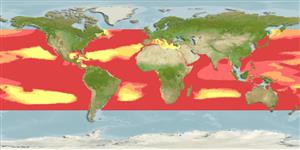Preferred temperature (Ref.
123201): 4.3 - 21.1, mean 10.2 °C (based on 3474 cells).
Índice de diversidade filogenética (Ref.
82804): PD
50 = 0.6270 [Uniqueness, from 0.5 = low to 2.0 = high].
Bayesian length-weight: a=0.00102 (0.00046 - 0.00225), b=3.06 (2.88 - 3.24), in cm total length, based on all LWR estimates for this body shape (Ref.
93245).
Nível Trófico (Ref.
69278): 3.5 ±0.0 se; based on diet studies.
Generation time: 3.7 ( na - na) years. Estimated as median ln(3)/K based on 1
growth studies.
Resiliência (Ref.
120179): Baixo, tempo mínimo de duplicação da população 4,5 - 14 anos (K=0.30; assuming semelparity with tm>5).
Fishing Vulnerability (Ref.
59153): Moderate to high vulnerability (51 of 100).
Nutrients (Ref.
124155): Calcium = 19 [6, 42] mg/100g; Iron = 0.295 [0.130, 0.805] mg/100g; Protein = 18.3 [15.8, 21.0] %; Omega3 = 0.177 [0.057, 0.572] g/100g; Selenium = 34.9 [11.9, 103.1] μg/100g; VitaminA = 9.08 [1.04, 75.23] μg/100g; Zinc = 0.379 [0.201, 0.745] mg/100g (wet weight);
